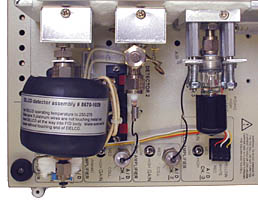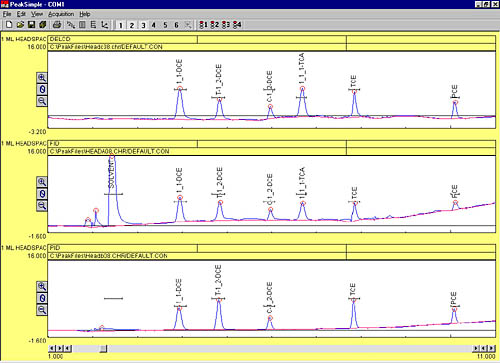| DELCD - Dry Electrolytic Conductivity Detector |
48
|
|
 |
The Dry Electrolytic Conductivity Detector is useful for low-level detection of chlorinated and brominated solvents in environmental samples and other trace analyses. In the picture above, a DELCD is mounted next to FID and PID detectors on an SRI GC. The three chromatograms shown below are from a similar SRI GC.
The DELCD is much like the ECD in sensitivity, but it is much more selective to halogens and blind to oxygen. The SRI DELCD differs from the traditional wet ELCD in that it uses neither a solvent electrolyte nor a nickel reaction tube, and the reaction products are detected in the gaseous phase. In the high sensitivity mode (no hydrogen, using dry cylinder air) the DELCD can detect down to the low picogram range. In this mode, the DELCD is about 100 times more sensitive than the FID/DELCD. However, the high sensitivity DELCD is susceptible to contamination from high concentrations of chlorinated hydrocarbons and hydrocarbon solvents.
| A 50 ppb Japanese VOC standard was placed into a VOA vial with water, and allowed to equlibrate at room temperature for 45 minutes before 1mL of headspace was injected into the On-column injector on the SRI GC. The FID chromatogram (center) shows all the components and the solvent. The DELCD (top) does not respond to the solvent, and the PID (bottom) does not detect the 1,1,1-TCA. |  |
|
8690-1026
|
DELCD detector
|
£3,640.00
|
|||
|
8670-1029
|
DELCD heater/collector
electrode assembly
|
£376.00
|
|||
|
DELCD
- Dry Electrolytic Conductivity Detector
|
48
|